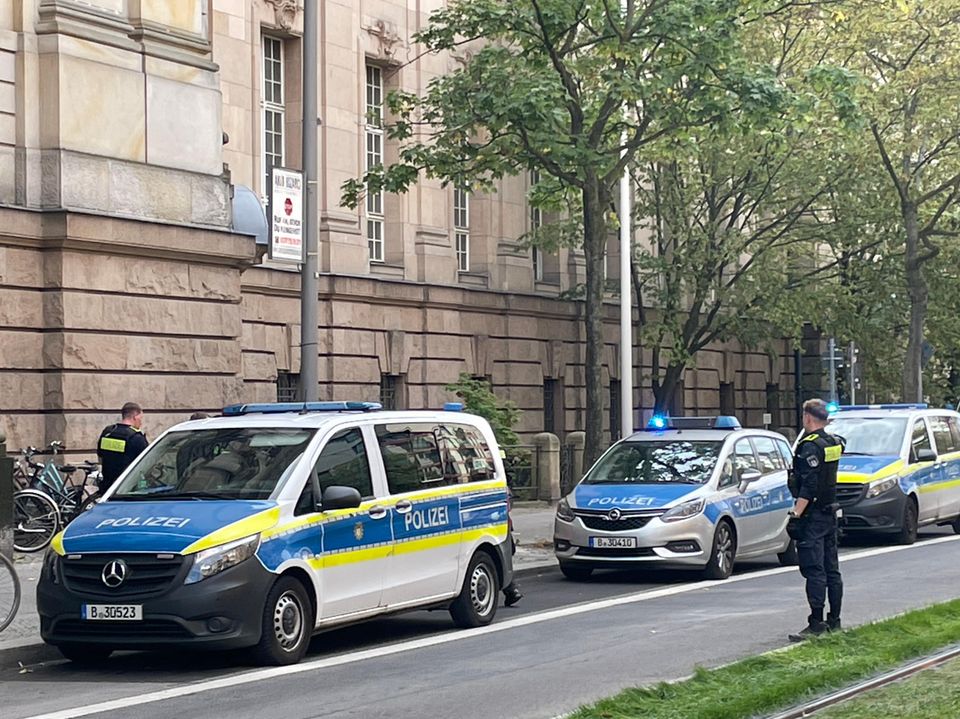Who stabbed little Anissa? At the trial in Berlin, friends and acquaintances of the mother and the defendant clashed.
The Berlin-Moabit Criminal Court, on Thursday afternoon around 2 p.m.: Screams ring through the stone entrance hall. People rush through the building in packs, causing jostling and hitting. Shouts can be heard.
“Whore!”
“Murderer!”
“Wait and see, the truth will come out!”
“You killed your child!”
The prison guards call for reinforcements. It escorts the flailing people, many of whom are beside themselves with anger, outside. The courthouse will be temporarily closed. The house alarm is triggered. All negotiations currently underway must be interrupted. No more access, not even for witnesses and lawyers. The clashes continue on the street, several police vehicles arrive, and scuffles break out again and again.
Thursday’s tumult is the preliminary highlight – or low point – of a trial before the Berlin regional court. For weeks, a crime has been being tried there that has moved Berlin like few before.

Police cars are parked in front of the criminal court in Berlin-Moabit, where there was an argument in the case of little Anissa
© Tilman Gerwien
20-year-old Gökdeniz A is in the dock. In February of this year, he is said to have killed the then five-year-old Anissa with multiple knife stabs in Pankow’s Bürgerpark. Gökdeniz A. was an acquaintance of Sibel C., Anissa’s mother. He was supposed to look after Anissa and her three younger siblings at a playground. When Anissa had to go to the toilet, he left with her – and came back without her. He allegedly lost sight of her after she urinated behind bushes at the Wollankstrasse S-Bahn station, according to his statement. But A. quickly became embroiled in contradictions and suspicion fell on him. Since then he has been silent. The charge is manslaughter.
During a break in the proceedings, relatives and friends clash in the hallways and in the stairwell of the court: those of Gökdeniz A. and those of Anissa’s mother. The mother, Sibel C., is harassed, kicked, thrown to the ground, and other women sometimes tear off her headscarf.
She had temporarily taken the defendant into her home. Because she felt sorry for him, as she says. Maybe also because it was very practical: Gökdeniz A. could also be used as a free childcare provider at any time.
Problem child looking for attention
The court offers deep insights into an environment in which it is not so easy to distinguish between victims and perpetrators. Everyone involved has Turkish roots. On the one hand, the suspect, a problem child from the start at school: in need of support and in a vain search for friendship, with major learning difficulties and an extremely low intelligence quotient of around 70. From time to time he tortured other children and attacked girls the breasts and pulled her by the ponytail. He once smeared the gym with his own feces.
“I thought he was incredibly needy. He needed a lot of help, a lot of attention, a lot of contact, a lot of support. That was what he was always missing,” said the head of the special school, which Gökdeniz A. had been waiting for for years went. “But at some point we lost him.” Another teacher who taught him says: “He had something like a child about him. I liked him.” At the end of her statement, she reaches for the tissue and wipes the tears from her eyes. As she leaves, she gives the defendant another silent nod. Gökdeniz A. nods back, a smile flashes across his face. Probably a goodbye forever.
According to the files, he is said to have been neglected and repeatedly beaten by his family. In the end he lived more or less on the streets – until he found refuge with Sibel C. But this Sibel C., who was previously only portrayed in public as a suffering mother from whom her child was cruelly taken away, now appears, at least partially, in a different light thanks to the testimony of a witness.
This witness, an ex-boyfriend of Sibel C.’s sister, who lived with C. for a short time, says that little Anissa, like her three younger siblings, was chronically neglected by her mother. There were “beatings,” “bad beatings, shouting, she instilled fear in the children.” Sibel C. also pursued prostitution on an internet portal. And she consumed drugs, even in the presence of the children. “I’ve experienced a lot,” said the witness. “But that was something new for me.”
The search for true guilt
In this trial, a world of neglect, emotional poverty, in which there is little security, but a lot of conflicts, broken biographies and rather fleeting contacts is unfolded before the youth chamber of the Berlin Regional Court. A world in which everyone is somehow a loser.
On the day of the tumult, the spectator benches are filled to capacity: relatives and friends who are struggling to contain themselves and have to be warned several times by the judge for their unrest. For them – that probably explains the violent confrontations – it is now a matter of preserving at least a vestige of dignity and family honor in this tragic crime.
For the defendant’s friends, Sibel C. actually had her daughter on her conscience: ultimately uninterested in her children, without love and care, with a dissolute lifestyle. In her eyes, Gökdeniz A. is the willing victim with whom Sibel C. wants to distract from her alleged failure as a mother. The defendant is the actual victim who, due to a lack of intelligence, cannot defend himself against the accusation of having killed little Anissa. For Sibel C. and her friends and acquaintances, however, it looks as if she is being dragged into the mud by exposing the most private and intimate details of her life in order to take away her dignity: as a mother and as a woman.
Although additional witnesses were actually invited, Judge Uwe Nötzel did not resume the hearing. The atmosphere in the hall and outside was too heated, and the safety concerns were probably too great. The next day of the hearing is next week. A verdict is expected to be made by mid-November.



